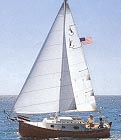 The Comfortable Pocket Yacht
The Comfortable Pocket Yacht 
|
|
|
Trailer Sailing |
Topics
The Annapolis Sailboat Show and The Short List
Every year during the 5 days around the Columbus Day weekend, what is advertised as the largest sailboat show in the United States is held in Annapolis Maryland. I hoped that this would be the one place where I could see the latest and greatest all in the same spot. My plan was to spend two or three days looking at the latest versions of the above designs. In addition, I should be able to talk to dealers and advocates of each design to learn more about their experiences. I also expected to see the bigger brothers of each of the trailerable boats at the same time. This would allow me make a final determination on the subject of my self imposed weight limitation. While the Annapolis Show is mainly a place for the builders to show off their largest and most expensive works, I did hope to find enough of the trailer sailor boats to make this worth the effort. The presence of literally a hundred or more vendors for sailboat accessories would also make this a worth while trip when it came time to enhance or upgrade my proposed purchase. The presence of so many other large boats would also allow comparisons with their features. This was due to the fact that I was still dreaming about the idea of starting out somewhat larger and non-trailerable. I also hoped to actually tour a Flicka 20 either at the show or in one of the local brokerage lots. This would allow a more realistic comparison of the extremes of trailer sailing. After all, the Flicka 20 with it’s 8 foot beam and 24 foot length on deck would meet all of my requirements. I was still trying to convince myself that there was a way to circumvent the problems associated with trailering a 6,000 pound boat. The first day did result in a successful trip to a brokerage lot where I saw four Flicka 20s and spoke with the owner of one of them for about one hour. During this time he gave me a complete tour of "his baby". In a nutshell, the Flicka 20 is all it is cracked up to be. An ideal definition of the term pocket cruiser. The boat that I toured was a 1983 model that had received immaculate care but the owner was forced to sell for health reasons. His annual sailing trips up to Maine would be a thing of the past. After this tour, I decided that the Flicka 20 would remain a dream for now. The Mid-West was just not a place for such a Blue Water cruiser. The next two days were a whirlwind of conversations with dealers and boat builders. It included several trips to local brokers to view nearby models that were not on display at the show. All in all, a very worthwhile trip. A comparison of the features available on a trailer sailor with those of their larger relatives seemed to convince me that smaller is better. The larger trailer sailors were generally 23 to 25 feet long and weighed around 4,000 to 5,000 pounds with their trailer and a small amount of equipment. While these boats offered a significant increase in interior comfort, it would decrease the utility and ease of trailering. I decided that if I were going to live near a large body of water than I would get another boat. For now, smaller would be better since I could use it in more places and much more often. I did examine the smaller ocean capable cruisers of 27 feet or less at brokerages. These also appeared to have all of the comforts that I could want and some still be ocean capable. This applied to the Flicka 20, the Dana 24, and some of the smaller Island Packets. The common thread in these ocean capable pocket cruisers was a full keel that gave the hull significant volume and standing room. According to the literature, this would come at the cost of performance, but this would again be of no concern to me if it came time to move up. The top players in my hunt for a comfortable pocket cruiser would be: The Com-Pac would head the list as the best choice for me.
A strong second choice
A distant third choice
The list had been cut down to size. The basic decision came down to a realization that small is beautiful. While the larger brothers of each of my "finalist" designs would all offer more room and comfortable accommodations; this would come at a cost of usability. My intention was to trailer to many different destinations and generally singlehand. In this effort, larger would translate to more troubles and costs. Just starting out, I wanted more variety of sailing experience and for this reason I would choose the smaller boats.
This page was last updated: 09/14/00 05:13:44 PM |
|
Copyright © 1998-2000 Jobst Vandrey |